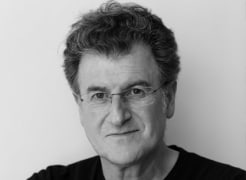
Galerie Lelong will present Alfredo Jaar's Shadows from February 14 through March 28, 2015. The artist's first solo exhibition in New York since 2009, Shadows is the second project in a trilogy of works exploring the power and politics of an iconic single image and follows The Sound of Silence, 2006. In Shadows, Jaar employs a photograph by Dutch photojournalist Koen Wessing taken in Nicaragua at the height of the 1978 insurrection. The photograph, which Jaar has described as perhaps the "strongest expression of grief" he has ever seen, was taken in Estelí, Nicaragua during the final days of oppression by the Somoza regime. The image depicts the moment shortly after two women are told of their father’s death. This will be only the second time that Shadows, which premiered at the SCAD Museum of Art in 2014, has been on view and will be reconfigured especially for the presentation at Lelong.
The structure of Shadows was inspired by Chili, September 1973, a photo-based book created by Wessing about that historic month in Chile. In this book, Wessing tells the story of the military coup in a sequence of images and without a single word. Wessing was one of the few international photographers to document the coup in Chile and the aftermath; in 1978 he went to Nicaragua and photographed the insurrection of the Sandinistas against Somoza. Viewers are guided through Shadows by the light of small sequential images that unravel the narrative. After walking through a dark corridor, the viewer is led to a central space in which an extraordinarily intense light emanates from a silhouetted image. This light illuminates and stuns the viewer, who becomes a participant in the action. Jaar’s choice to use the frame of a silhouette as a source of light intensifies the symbolic representation of grief and loss. As in many of Jaar’s works that explore the politics of images, Shadows engages the viewer to think of these two lives embodying many innocents who die in conflict or are oppressed. According to the artist, Shadows is also an homage to Koen Wessing (1942-2011), a photographer who did not care about words and trusted that his images would speak for themselves.
Light and illumination have been an important part of Jaar’s work since 2002. The artist's Lament of the Images, 2002, first shown in Documenta X, introduced this strategic device. Lament of the Images will be shown at The Museum of Modern Art, New York in March 2015 as part of recent acquisitions. The Sound of Silence has been exhibited 25 times world-wide to date, in 18 countries and 10 languages; it was recently acquired by the Philadelphia Museum of Art and the Museum of Contemporary Art in Chicago.
About Nicaragua, 1978:
In a disturbingly similar parallel to Chile’s dictatorship, Nicaragua endured a 43-year military dictatorship instated by Anastasio Somoza in 1936 and enforced until 1979 by his two sons, first Luis Somoza and then Anastasio Somoza. Like that of Pinochet in Chile, the Somoza regime was fueled by U.S. funds and support. The U.S. installed Somoza in power by helping him mastermind the assassination of Augusto Sandino, the leader of the resistance to the U.S. occupation of Nicaragua. The U.S. Marines, having occupied Nicaragua since 1912, were expelled from the country by General Sandino in 1933 and thereafter employed the Somoza dynasty and
their U.S.-trained National Guard as a strategy to sustain their influence over the region. The followers of Sandino, the Sandinistas, did not retake power until 1979, when they overthrew the last of the Somozas. In September 1978 at the time of Wessing’s visit, the regime controlled all aspects of Nicaraguan lives, from the economy, wealth, and land to elections and media. Somoza’s greed and abuse particularly persecuted and starved the country’s large population of campesinos, whom Wessing spent much of his time photographing.
About Alfredo Jaar:
Alfredo Jaar is an artist, architect, and filmmaker who lives and works in New York. He has participated in the Biennales of Venice (1986, 2007, 2009, 2013), São Paulo (1985, 1987, 2010), as well as Documenta (1987, 2002) in Kassel. A selection of recent solo museum exhibitions since his last show at the gallery include SKMU, Norway; KIASMA, Helsinki; and Parque de la Memoria, Buenos Aires, (2014); Fondazione Merz, Torino (2013); Berlinische Gallery, Neue Gesellschaft fur bildende Kunst e.V.; and Alte Nationalgalerie, Berlin (2012); Stedelijk Museum, Amsterdam (2011); Hangar Bicocca and Spazio Oberdan, Milan (2009). In 2013 Alfredo Jaar represented Chile at the 55th Venice Biennale. He recently completed two important public commissions: The Geometry of Conscience, a memorial located next to the recently opened Museum of Memory and Human Rights in Santiago de Chile, and Blind Spot, a memorial to the disappeared in Buenos Aires. More than 50 monographic publications have been published about his work; the most recent is Tonight No Poetry Will Serve, published by KIASMA, Helsinki. Jaar became a Guggenheim Fellow in 1985 and a MacArthur Fellow in 2000. In conjunction with his exhibition at Lelong, Jaar will lecture at the 92nd Street Y on March 12, 2015.
Alfredo Jaar
Shadows, 2014
Installation with LED lights, aluminum, video projection and six lightboxes with black and white transparencies
Lightboxes: 12 x 13 inches (30.5 x 33 cm) each
Projection: 116 x 174 inches (294.6 x 442 cm)
Overall dimensions variable
Lighting engineering by Tommy Voeten
Original photographs by Koen Wessing (1942-2011): Estelí, Nicaragua, September 1978
The collection and copyright of Koen Wessing is administered by the Nederlands Fotomuseum, Rotterdam
Premiered at the SCAD Museum of Art, Feb. 18 – June 29, 2014
With generous support from SCAD and the Ford Foundation
Special thanks Kasper, Karijn, Marie and Merel Wessing.